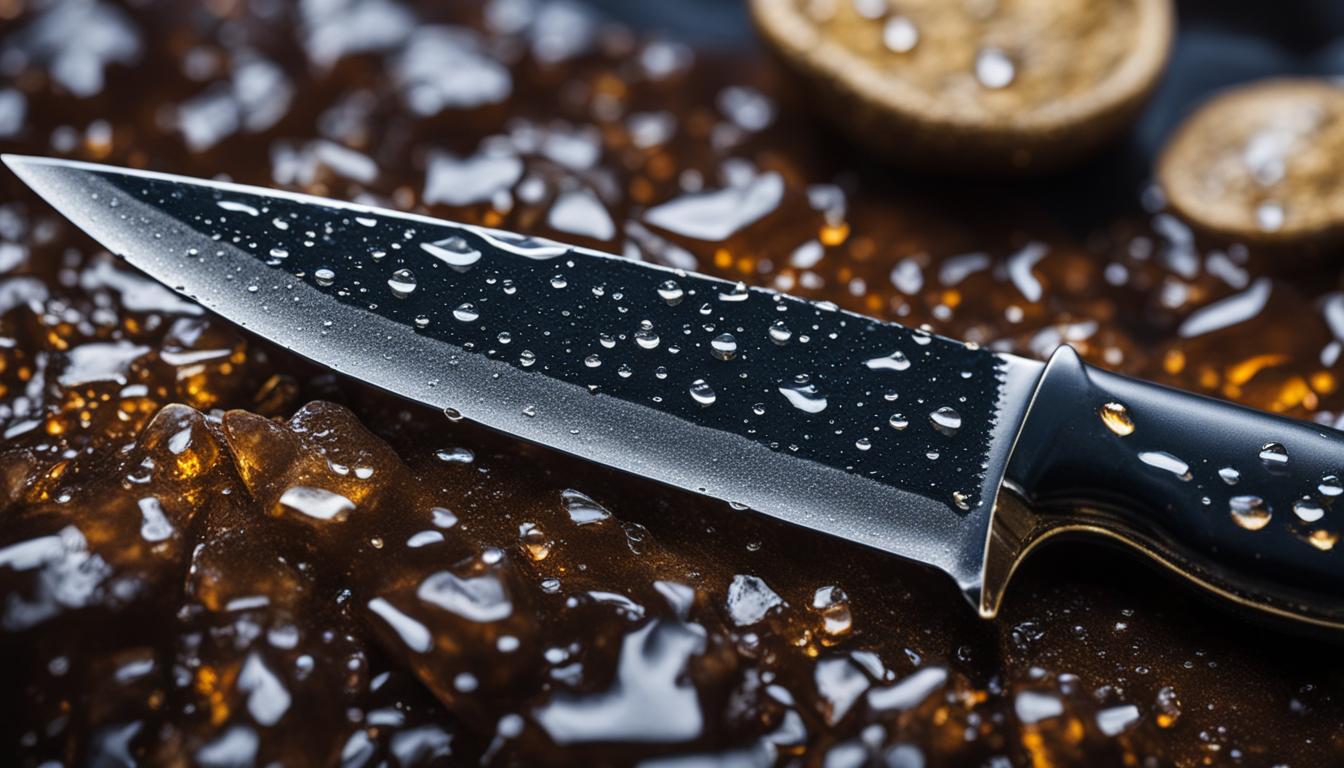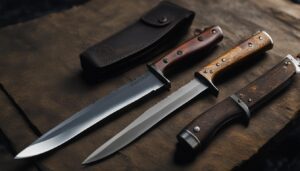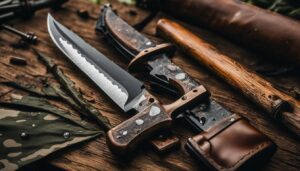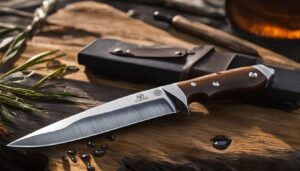Steel rusts, and that includes high carbon knives and stainless steel knives. Rust, that reddish-brown buildup, occurs when the iron in steel reacts with oxygen and water. As an outdoor enthusiast, I understand the importance of maintaining and preserving my hunting knives. That’s why I’ve researched and implemented the top rust prevention measures to ensure the longevity and performance of my valuable tools.
Key Takeaways:
- Regular cleaning and drying after each use is crucial to prevent rust on hunting knives.
- Applying blade wax, like the ones from Montana Knife Company, adds an extra layer of protection against moisture.
- Choosing coatings such as Parkerizing and Cerakote can effectively prevent rust on knives.
- Avoid using oils that attract moisture and are not food safe.
- Be cautious of the harsh effects of saltwater on knives.
Understanding Rust vs. Knife Patina
Rust is a serious concern for outdoor enthusiasts who rely on their hunting knives. It occurs when the iron in steel reacts with oxygen and water, leading to the reddish-brown buildup that can corrode and damage the blade. On the other hand, knife patina is a natural and desirable discoloration that develops on the surface of a carbon steel blade. This yellowish color is a result of exposure to air, moisture, and other substances. While rust can degrade the performance and longevity of a knife, knife patina actually acts as a protective layer.
Knife patina forms through a process called oxidation, where the metal reacts with elements in its environment over time. As the patina develops, it creates a barrier that helps shield the blade from rust and corrosive agents. Additionally, knife patina can enhance the aesthetic appeal of the blade, adding character and charm. Many experienced hunters and outdoor enthusiasts appreciate the unique appearance that a well-developed patina brings to their knives.
It’s important to note that not all knives are susceptible to rust. Stainless steel blades, for example, are resistant to corrosion due to the high levels of chromium present in the alloy. However, high-carbon steel blades are more prone to rust and require extra care and maintenance to prevent oxidation. By understanding the difference between rust and knife patina, outdoor enthusiasts can better protect their knives and ensure their longevity for years of reliable use.
Key Points:
- Rust is the result of the iron in steel reacting with oxygen and water.
- Knife patina is the yellowish discoloration that develops on the surface of carbon steel blades.
- Knife patina acts as a protective barrier against rust and corrosion.
- Stainless steel blades are resistant to rust, while high-carbon steel blades require extra care.
How Montana Knife Company Prevents Rust
Montana Knife Company is dedicated to ensuring their knives are resistant to rust by employing effective rust prevention methods and coatings. The company understands the importance of maintaining the integrity of their blades, especially in outdoor environments where exposure to moisture and harsh conditions is common. In order to provide their customers with high-quality knives that stand the test of time, Montana Knife Company utilizes two key rust prevention techniques: Parkerizing and Cerakote coatings.
Parkerizing coating: This method involves phosphate coating the metal, resulting in a blackened appearance that not only enhances the aesthetics of the blade but also provides excellent resistance against rust. The Parkerizing process forms a durable protective layer on the knife, preventing the steel from reacting with moisture and oxygen, which are the main culprits behind rust formation. This coating offers outstanding durability and reliability, ensuring that Montana Knife Company’s blades remain rust-free even in challenging outdoor conditions.
Cerakote coating: Montana Knife Company also utilizes Cerakote, a state-of-the-art ceramic finish known for its incredible toughness and resistance to wear and tear. The Cerakote coating is applied through a special process that results in a hard, baked-on finish that enhances the durability of the blade. Not only does it protect against rust, but it also provides an additional layer of defense against scratches and abrasions, making the knives even more resilient. With Cerakote, Montana Knife Company ensures their blades can withstand the rigors of outdoor activities without compromising their rust prevention capabilities.
It is important to note that while these coatings greatly reduce the risk of rust, proper care and maintenance are still essential to maximize the lifespan of the knives. Even with Parkerizing and Cerakote coatings, it is advisable to clean and dry the blades after each use, as well as apply blade wax regularly to further protect against moisture. By following these rust prevention tips and utilizing the advanced coatings provided by Montana Knife Company, outdoor enthusiasts can enjoy their knives for years to come without worrying about rust.
| Rust Prevention Method | Description |
|---|---|
| Parkerizing | A phosphate coating that turns the metal black, providing excellent rust resistance. |
| Cerakote | A hard, baked-on ceramic finish that offers exceptional durability and prevents rust and scratches. |
Tips for Preventing Rust on Knives
Preventing rust on knives is essential for maintaining their performance and longevity. By following these rust prevention tips and proper knife maintenance, you can ensure that your knives stay in top shape for all your outdoor adventures.
Cleaning and Drying
After each use, it is crucial to clean your knife thoroughly with warm water and mild soap. This helps remove any dirt, debris, or acidic substances that can accelerate rust formation. Make sure to dry the blade completely using a clean towel or cloth. Moisture trapped on the blade can contribute to rust development, so ensure it is completely dry before storing or using your knife again.
Applying Blade Wax
In addition to cleaning and drying, applying blade wax is an effective rust prevention technique. Blade wax forms a protective barrier on the blade’s surface, preventing moisture from seeping into any scratches or imperfections in the coating. The blade wax offered by Montana Knife Company is particularly recommended for its high-quality formulation.
Keeping the Sheath Dry
Another crucial aspect of preventing rust on knives is to keep the sheath dry and clean. Moisture can accumulate inside the sheath, leading to rust formation on the blade. By regularly checking and ensuring the sheath is dry and free from any moisture or debris, you can help maintain the knife’s integrity and prevent rusting.
Following these rust prevention tips, including proper cleaning, applying blade wax, and keeping the sheath dry, will help you protect your hunting knives from rust and ensure they remain in excellent condition for all your outdoor pursuits.
Choosing the Right Hunting Knife for Outdoor Adventures
When it comes to selecting a hunting knife for your outdoor adventures, there are several factors to consider. The right hunting knife can make a significant difference in your overall experience, so it’s important to choose one that suits your needs and preferences. Here are some key points to keep in mind:
1. Purpose:
First and foremost, consider the purpose of your hunting knife. Are you planning to use it mainly for skinning and field dressing game? Or do you need a more versatile knife that can handle a variety of tasks? Understanding your specific requirements will help you narrow down your options and find the knife that best meets your needs.
2. Size and Weight:
The size and weight of the knife are also important factors to consider. A larger, heavier knife may offer more cutting power, but it can be cumbersome to carry and handle. On the other hand, a smaller, lightweight knife may be more convenient to carry but may not be as robust in certain situations. Choose a size and weight that feels comfortable and balanced in your hand.
3. Blade Material:
The blade material plays a crucial role in the performance and durability of a hunting knife. High-carbon steel blades are known for their exceptional sharpness and edge retention, but they require more maintenance to prevent rust. Stainless steel blades, on the other hand, offer excellent resistance to rust and corrosion but may not hold an edge as long. Consider your maintenance preferences and the specific outdoor conditions you’ll be facing when selecting the blade material.
4. Handle Material:
The handle material of a hunting knife is essential for a comfortable and secure grip. Common handle materials include wood, bone, plastic, or synthetic materials. Each material offers its own set of advantages and considerations, such as durability, grip texture, and resistance to moisture. Choose a handle material that feels comfortable in your hand and suits your personal preferences.
By considering factors like purpose, size and weight, blade material, and handle material, you can make an informed decision when choosing the right hunting knife for your outdoor adventures. Remember to set a budget and look for high-quality options within your price range. With the right hunting knife in hand, you’ll be ready to tackle any outdoor challenge.
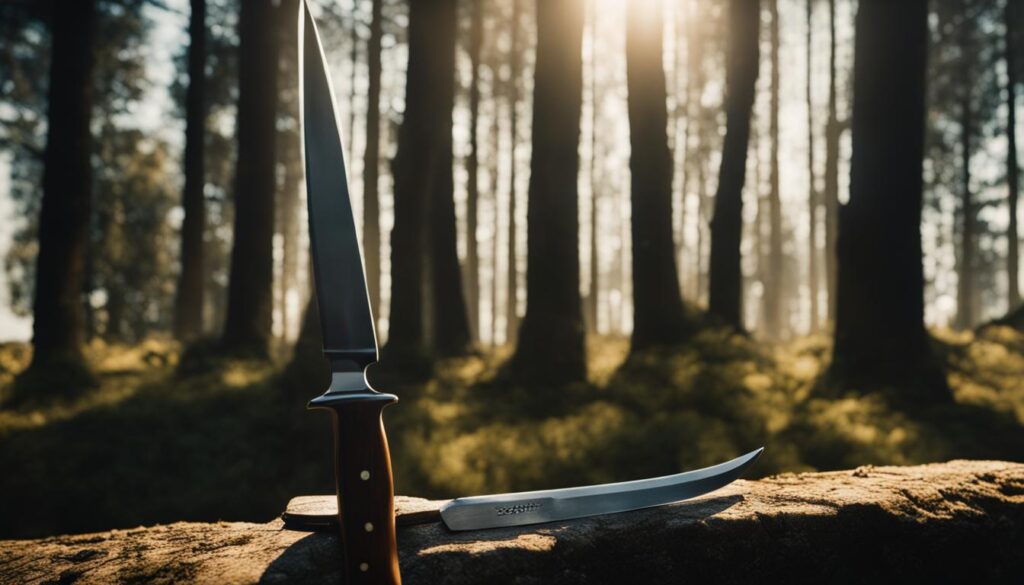
Types of Outdoor Knives for Different Uses
When it comes to outdoor adventures, having the right knife can make all the difference. There are various types of outdoor knives available, each designed for specific purposes and activities. Whether you’re a hunter, survivalist, or simply enjoy spending time in the great outdoors, understanding the different types of knives can help you choose the perfect tool for your needs.
One popular type of outdoor knife is the hunting knife. Designed with a sharp blade and a curved edge, hunting knives are ideal for skinning and field dressing game. They are typically made of high-quality steel to ensure durability and edge retention. Hunting knives come in various sizes, allowing you to choose one that suits your preference and the type of game you’ll be hunting.
Another type of outdoor knife is the survival knife. These knives are versatile tools that can handle a range of outdoor tasks. They often feature a serrated edge, which is useful for cutting rope or other tough materials. Some survival knives even come with additional features, such as a built-in fire starter or a whistle for signaling for help. These knives are built to withstand harsh conditions and are essential for any outdoor enthusiast.
| Type of Knife | Main Features |
|---|---|
| Hunting Knife | Sharp blade, curved edge, designed for skinning and field dressing game |
| Survival Knife | Versatile tool, often with serrated edge, additional features like fire starter or whistle |
| Folding Knife | Compact design, easily accessible, ideal for everyday carry |
In addition to hunting and survival knives, there are also folding knives, which are compact and convenient for everyday carry. These knives have a folding mechanism that allows the blade to be safely folded into the handle when not in use. Folding knives are available in various sizes and styles, offering versatility and practicality for everyday tasks and outdoor adventures.
When choosing an outdoor knife, consider the intended use, the materials used in its construction, and your personal preferences. It’s important to select a knife that feels comfortable to hold and use, as well as one that suits your specific needs. Whether you’re an avid hunter, camper, or outdoor enthusiast, having the right knife by your side can enhance your outdoor experience and provide you with a reliable tool for various tasks.
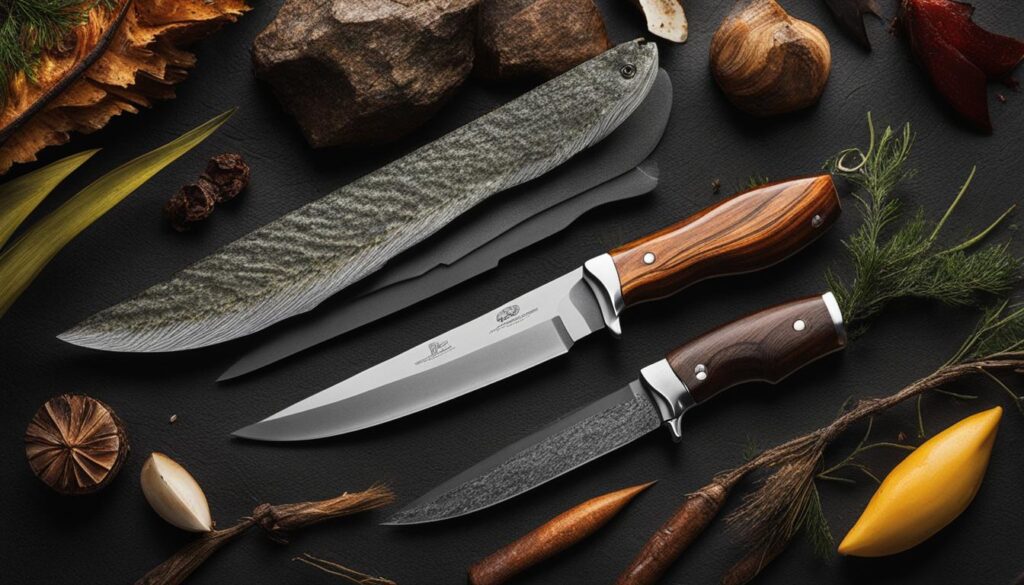

Key Takeaways:
- There are various types of outdoor knives, including hunting knives, survival knives, and folding knives.
- Hunting knives are designed for skinning and field dressing game, while survival knives are versatile tools for various outdoor tasks.
- Folding knives are compact and convenient for everyday carry.
- When choosing an outdoor knife, consider the intended use, materials used, and personal preferences.
Caring for Your Outdoor Knife
Proper maintenance and care are essential to keep your outdoor knife in excellent condition. By following these simple steps, you can ensure the longevity and optimal performance of your knife.
Cleaning
After each use, clean your knife thoroughly with warm water and mild soap. This will remove any dirt, debris, or residue that may have accumulated during your outdoor adventures. Pay special attention to the blade and handle, making sure to clean all crevices and hard-to-reach areas. Once cleaned, dry your knife completely to prevent rust and corrosion.
A clean knife is a happy knife. Regular cleaning not only preserves the appearance of your knife but also helps maintain its functionality.
Sharpening
Regular sharpening is crucial to keep your knife’s blade sharp and efficient. You can use sharpening stones, rods, or guided systems to ensure a precise and even edge. Take your time and follow the manufacturer’s instructions for the best results. Remember to always sharpen away from your body to avoid accidents.
“A sharp knife is a safe knife.” Keeping your knife sharp reduces the risk of slips and accidents, making it safer to use during your outdoor activities.
Lubricating and Storage
Lubricating the moving parts of your folding knife is essential to ensure smooth operation. Apply a small amount of lubricant, specifically designed for knives, to keep the pivot point and other mechanisms working smoothly. Additionally, store your knife in a dry, cool environment when not in use. Avoid exposure to moisture, extreme temperatures, and corrosive substances that can damage the blade or handle.
Proper lubrication and storage help protect your knife from rust, corrosion, and other forms of damage, preserving its quality and performance for years to come.
By taking proper care of your outdoor knife through regular cleaning, sharpening, lubricating, and storage, you can enjoy its reliability and functionality during all your adventures.
Conclusion
Protecting hunting knives from rust is crucial for outdoor enthusiasts. It is important to understand the difference between rust and knife patina, as knife patina actually protects the blade from corrosion. To prevent rust on their knives, Montana Knife Company uses Parkerizing and Cerakote coatings, which provide excellent rust prevention. They also recommend a few key maintenance practices, such as regularly cleaning and drying the knife after each use, as well as applying blade wax to maintain its performance.
When selecting the right hunting knife, it is important to consider several factors, including the purpose of the knife, its size, weight, blade and handle material, and your budget. By carefully considering these factors, you can choose a hunting knife that suits your specific needs. Additionally, there are various types of outdoor knives available for different uses, such as hunting knives, survival knives, folding knives, EDC knives, multi-tool knives, and fishing knives.
Proper maintenance and care are essential to ensure the longevity and optimal performance of your outdoor knife. This includes regular cleaning, sharpening, lubricating the moving parts of folding knives, and storing the knife in a dry and cool environment. By following these rust prevention measures and maintaining your knife properly, you can keep your hunting knife in top shape for all your outdoor adventures.
FAQ
How does rust develop on knives?
Rust develops when the iron in steel reacts with oxygen and water, resulting in a reddish-brown buildup on the surface of the knife.
What is the difference between rust and knife patina?
Rust is a corrosive buildup that can destroy a blade if left unchecked, while knife patina is a yellowish color that develops on carbon steel blades and actually protects them from rust.
How does Montana Knife Company prevent rust on their knives?
Montana Knife Company uses Parkerizing and Cerakote coatings on their knives, which are effective in preventing rust. Parkerizing is a process that turns the metal black and makes it resistant to rust, while Cerakote is a durable ceramic finish that provides resistance to wear and tear.
What steps can I take to prevent rust on my knives?
To prevent rust on knives, it is important to clean the blade with soapy water and dry it completely after each use. Applying blade wax can also help prevent moisture from getting underneath scratches in the coating. Additionally, keeping the sheath dry and avoiding exposure to saltwater are crucial for rust prevention.
What should I consider when choosing a hunting knife?
When selecting a hunting knife, it is important to consider the purpose, size, weight, blade material, handle material, and budget. High-carbon steel blades provide durability and sharpness but require more maintenance, while stainless steel blades are resistant to rust. Choose a knife that is comfortable to carry and use.
What are the different types of outdoor knives?
There are various types of outdoor knives, including hunting knives, survival knives, folding knives, EDC knives, multi-tool knives, and fishing knives. Each type is designed for specific uses and features different characteristics and additional tools.
How should I care for my outdoor knife?
Proper maintenance and care are essential to keep outdoor knives in excellent condition. After each use, clean the knife thoroughly with warm water and mild soap, and dry it completely to prevent rust and corrosion. Regularly sharpen the knife and lubricate the moving parts of folding knives. Store the knife in a dry, cool environment when not in use.
